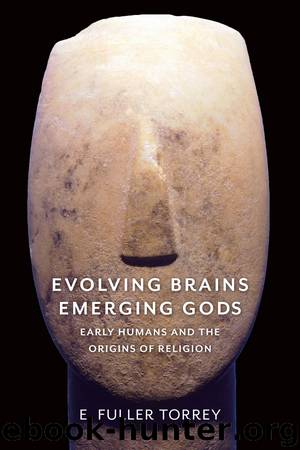Evolving Brains, Emerging Gods by E. Fuller Torrey

Author:E. Fuller Torrey
Language: eng
Format: epub
Publisher: Columbia University Press
The second thing that had to happen before the higher gods could emerge was the coming together of a critical mass of people. Groups of hunter-gatherers, which usually numbered fewer than 100 people, may have honored ancestor spirits and spirits of nature, but there would have been little reason to elevate these spirits to deities. As groups of hunter-gatherers came together and settled in villages and towns, however, it would have been necessary to establish a hierarchy among the competing spirits, just as it was necessary to do so among the human leaders of the various hunter-gatherer groups. Out of this hierarchy of spirits emerged the first gods, which were simply high-ranking spirits with advanced degrees conferred by a consensus of the people.
The population increase that took place during the agricultural revolution, fueled by a stable food supply made possible by the domestication of plants and animals, resulted in the coming together of the critical mass of people. When Göbekli Tepe was being used as a ceremonial center 11,000 years ago, the world’s population was, according to estimates, approximately five million. When the world’s first temple in Mesopotamia was being used to honor a god 6,000 years ago, the world’s population, according to estimates, increased to approximately 100 million, and by 2,000 years ago, to 300 million.54
A relationship between the size of a population and the type of gods that exist in that population has been clearly established. In 1960 Guy Swanson, a psychologist at the University of California at Berkeley, published a study of gods in 50 “primitive” societies, a sample of George Murdoch’s ethnographic database of 556 societies. Swanson reported a significant correlation between societies that were more socially and politically complex (had more “sovereign organizations”) and the existence of “high gods” (“a god who rules the world and heavens”). A more recent study reported a highly significant correlation between the size of societies (number of levels of political authority beyond the local community) and the existence of “moralizing gods” (“gods who tell people what they should and should not do”). This relationship was summarized by Azim Shariff, a psychologist at the University of Oregon, in a paper aptly titled “Big Gods Were Made for Big Groups.” Sheriff noted that “big gods … tend to be relatively recent Holocene innovations and ones that developed only in large, complex societies.” The association of “big gods” with big populations is also emphasized in recent books on the god-is-watching-you theory of religion, summarized in chapter 8.55
Download
This site does not store any files on its server. We only index and link to content provided by other sites. Please contact the content providers to delete copyright contents if any and email us, we'll remove relevant links or contents immediately.
Sapiens: A Brief History of Humankind by Yuval Noah Harari(14168)
Sapiens by Yuval Noah Harari(5266)
Pale Blue Dot by Carl Sagan(4861)
Homo Deus: A Brief History of Tomorrow by Yuval Noah Harari(4779)
Livewired by David Eagleman(3626)
Origin Story: A Big History of Everything by David Christian(3592)
Brief Answers to the Big Questions by Stephen Hawking(3319)
Inferior by Angela Saini(3211)
Origin Story by David Christian(3119)
The Gene: An Intimate History by Siddhartha Mukherjee(3014)
Signature in the Cell: DNA and the Evidence for Intelligent Design by Stephen C. Meyer(2999)
The Evolution of Beauty by Richard O. Prum(2916)
Aliens by Jim Al-Khalili(2766)
How The Mind Works by Steven Pinker(2697)
A Short History of Nearly Everything by Bryson Bill(2582)
Sex at Dawn: The Prehistoric Origins of Modern Sexuality by Ryan Christopher(2442)
From Bacteria to Bach and Back by Daniel C. Dennett(2425)
Endless Forms Most Beautiful by Sean B. Carroll(2403)
Who We Are and How We Got Here by David Reich(2376)
